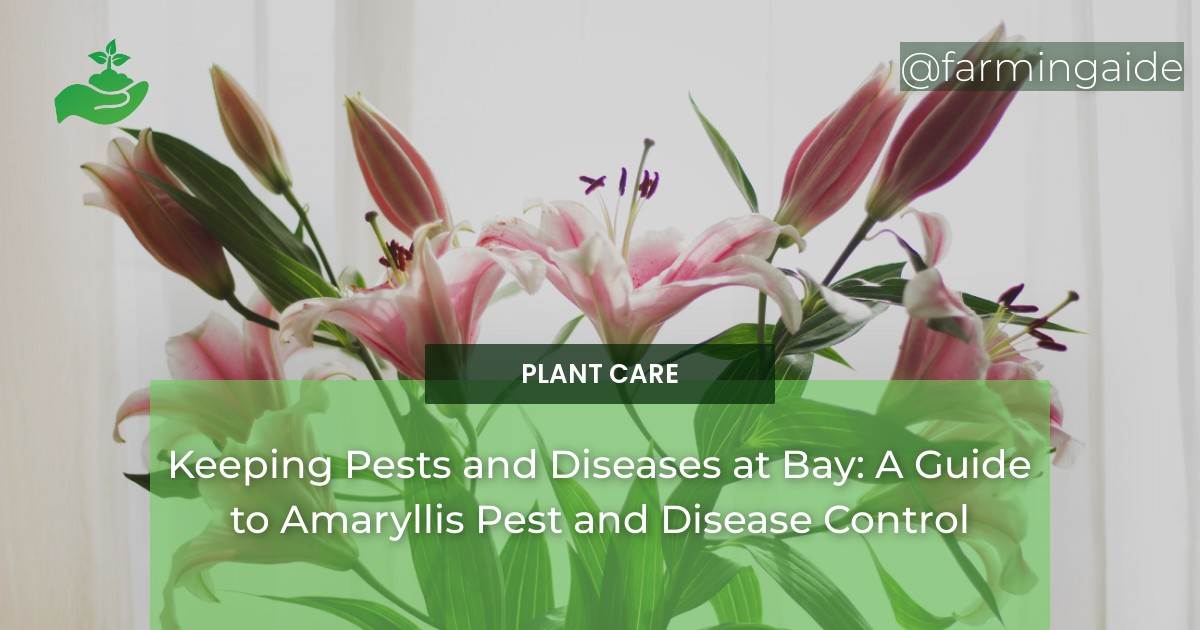Amaryllis plants are a popular choice for gardeners and indoor plant enthusiasts alike. With their stunning blooms and ease of care, it’s no wonder why they have become a staple in many homes and gardens. However, like any plant, Amaryllis is not immune to pests and diseases that can hinder their growth and overall health. As a gardener or plant lover, it’s important to be aware of these potential threats and how to prevent and treat them effectively. In this comprehensive guide, we will delve into the world of Amaryllis pest and disease control, covering everything from common pests and diseases to natural remedies and prevention methods. By the end of this article, you will have all the knowledge you need to keep your Amaryllis plants thriving and free from pests and diseases.
Common Pests and Diseases Affecting Amaryllis Plants
Amaryllis plants are susceptible to a variety of pests and diseases, some of which can cause serious damage if left untreated. The following are some of the most common pests and diseases that can affect Amaryllis plants:
- Aphids: These small, soft-bodied insects feed on the sap of plants and can quickly multiply, causing stunted growth and distorted leaves.
- Mealybugs: These white, cottony pests also feed on plant sap and can cause wilting and yellowing of leaves.
- Thrips: These tiny insects can cause leaves to become distorted and discolored, and can also transmit viruses to plants.
- Red Spider Mites: These minuscule pests can cause yellowing and mottling of leaves, as well as webbing on the plant.
- Bulb Rot: This fungal disease can cause bulbs to become soft and mushy, leading to stunted growth and eventual death of the plant.
- Leaf Scorch: This bacterial disease causes brown, dead spots on leaves and can lead to defoliation.
It’s important to keep a close eye on your Amaryllis plants and take action at the first sign of any of these pests or diseases. Early detection and treatment can prevent the problem from becoming more severe and potentially killing your plant.
Preventing Pests and Diseases in Amaryllis Plants
The best way to deal with pests and diseases in Amaryllis plants is to prevent them from occurring in the first place. Here are some simple steps you can take to keep your plants healthy and pest-free:
- Cleanliness: Keep your plants and their surrounding areas clean and free from debris, as this can attract pests and disease-causing organisms.
- Quarantine: If you bring a new plant into your home or garden, make sure to quarantine it for a few weeks to ensure it’s not carrying any pests or diseases.
- Proper watering: Amaryllis plants should be watered sparingly, as overwatering can create the perfect environment for pests and diseases to thrive.
- Good air circulation: Make sure your plants have adequate air circulation, as this can prevent the buildup of humidity, which can lead to fungal diseases.
- Healthy soil: Use well-draining soil and avoid over-fertilizing, as this can also create an ideal environment for pests and diseases.
By following these preventative measures, you can significantly reduce the risk of pests and diseases in your Amaryllis plants.
Natural Remedies for Amaryllis Pests and Diseases
If you do find your Amaryllis plants have been affected by pests or diseases, there are several natural remedies you can try before resorting to harsh chemicals. These include:
- Neem oil: This natural oil is an effective insecticide and fungicide that can be used to treat a variety of pests and diseases.
- Diatomaceous earth: This powder is made from the fossilized remains of marine organisms and can be sprinkled around plants to repel pests.
- Garlic spray: Garlic has natural anti-fungal and anti-bacterial properties and can be made into a spray to treat fungal diseases.
- Companion planting: Planting certain herbs and flowers alongside your Amaryllis can repel pests and attract beneficial insects.
It’s important to note that natural remedies may take longer to show results compared to chemical treatments. However, they are a safer and more environmentally-friendly option for controlling pests and diseases.
How Does Soil Management and Composting Help in Controlling Amaryllis Pests and Diseases?
Proper soil management and composting for amaryllis can greatly reduce the risk of pests and diseases. Well-draining soil and nutrient-rich compost help to create a healthy environment for amaryllis plants, making them more resistant to common pests and diseases, such as aphids and bulb rot.
How Can Eco-Friendly Practices Help in Controlling Pests and Diseases for Amaryllis Plants?
When it comes to controlling pests and diseases for amaryllis plants, sustainable practices for amaryllis can make a big difference. By avoiding chemical pesticides and focusing on natural remedies like neem oil and companion planting, you can maintain a healthy environment for your plants while keeping pests and diseases at bay.
Conclusion
Amaryllis plants are a beautiful addition to any home or garden, but like any plant, they are susceptible to pests and diseases. By being aware of the common pests and diseases that can affect these plants, taking preventative measures, and using natural remedies when necessary, you can keep your Amaryllis plants healthy and thriving. Remember to regularly inspect your plants and take action at the first sign of any problems to prevent them from becoming more severe. With the knowledge and tips provided in this guide, you can keep pests and diseases at bay and enjoy your Amaryllis plants for years to come.


